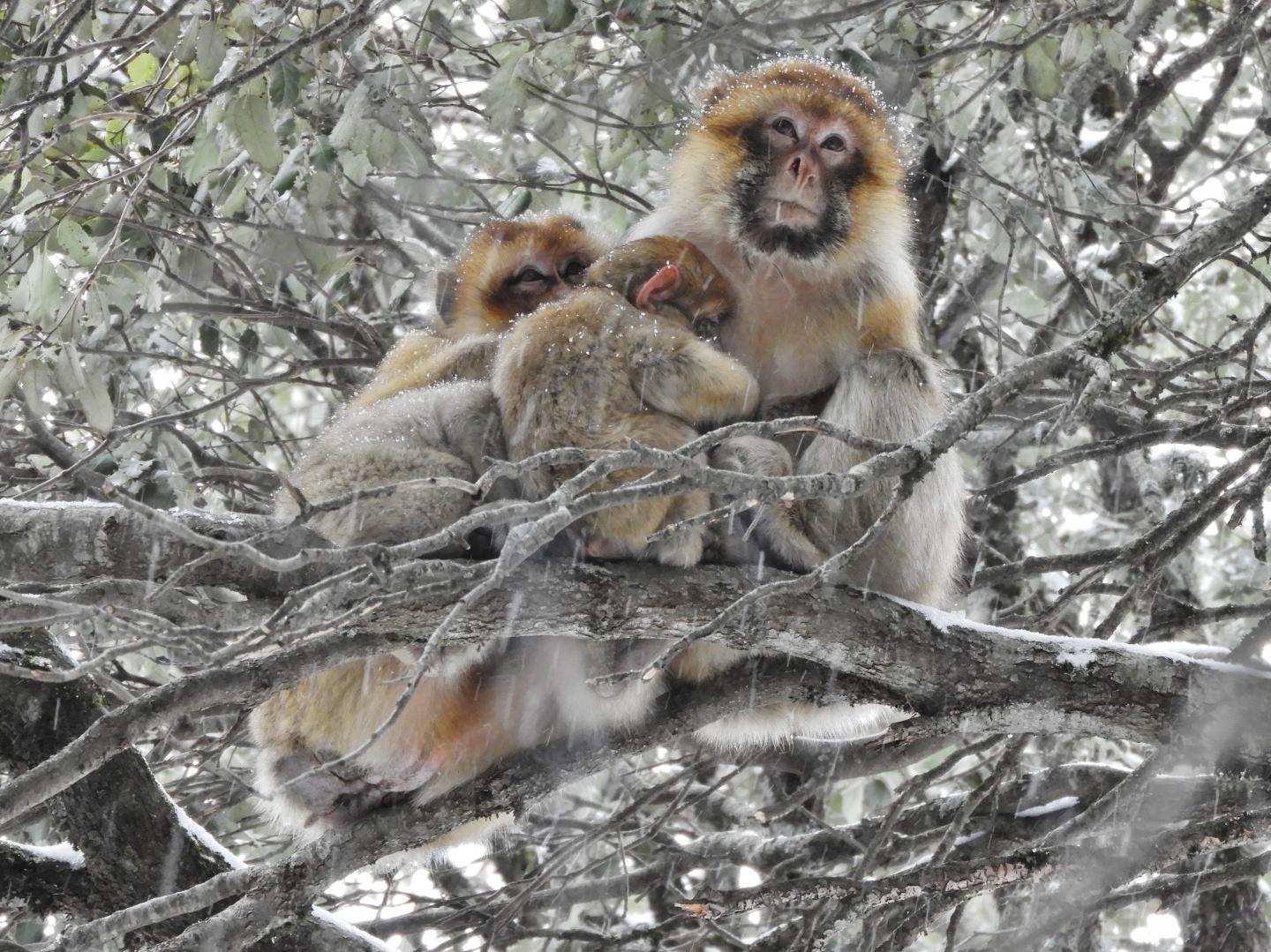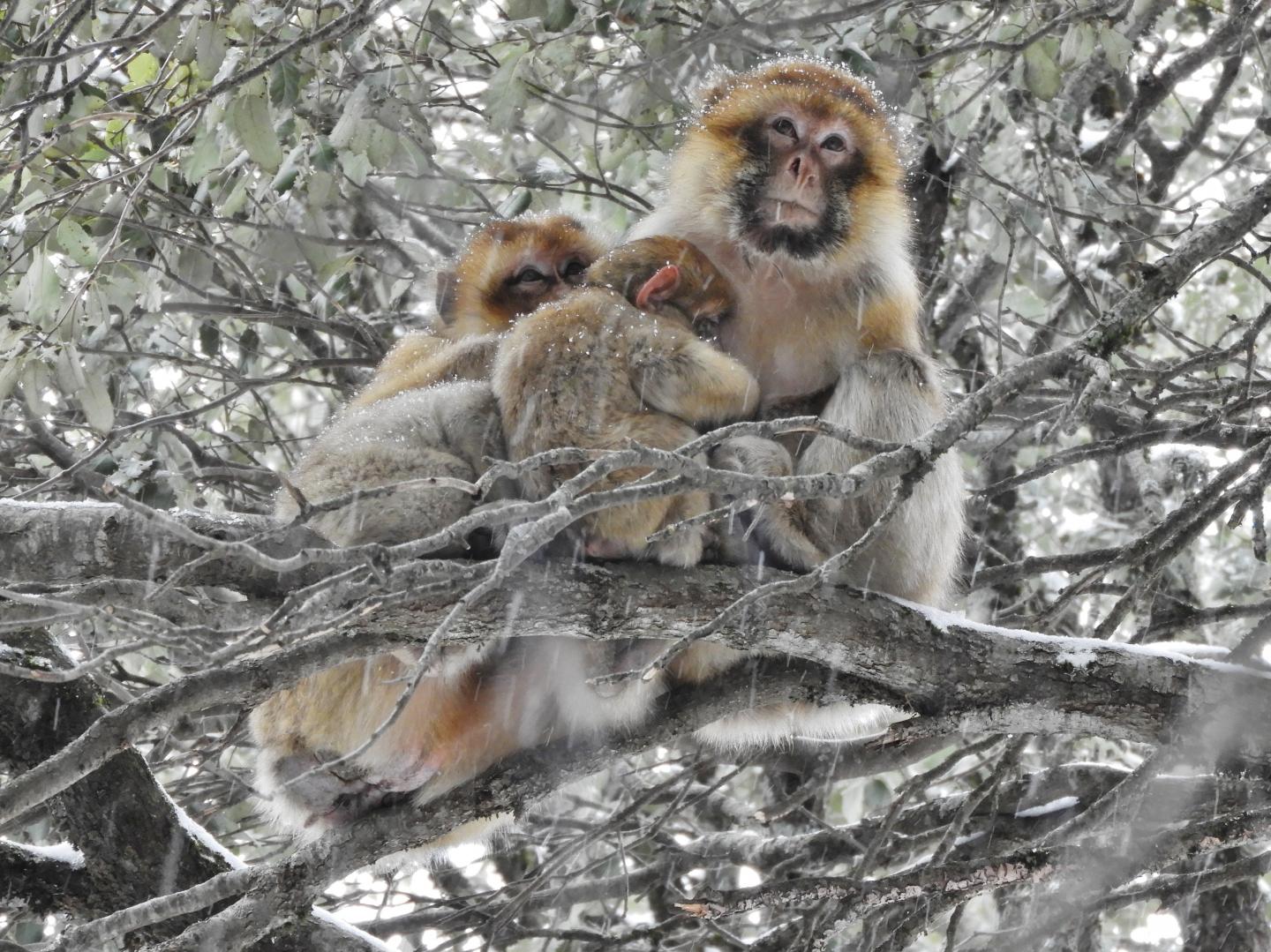
Credit: Liz Campbell
Wild monkeys which have more social partners form larger huddles in adverse weather and have a better chance of surviving winter, new research has found.
Behavioural ecologists studied wild Barbary macaques in Morocco and found that monkeys that had more social partners – the monkeys they groomed with – would form larger huddles at night than those animals with fewer social partners, allowing them to save more energy for growth and reproduction.
This method of keeping warm, called social thermoregulation, means that the macaques with more grooming partners would stay warmer, spend less energy on maintaining body temperature and be less exposed to environmental stress, increasing their probability of surviving winter.
The study is the first to show that such social huddling may be a mechanism that connects social bonding to higher "fitness" – the term used by scientists to measure of how well animals can cope with their local ecological conditions, usually measured by reproductive success and survival.
Dr Bonaventura Majolo, a behavioural ecologist based in the School of Psychology at the University of Lincoln, carried out the study with Liz Campbell, Programme Director at the Moroccan Primate Conservation Foundation, who previously worked as a researcher studying Barbary macaque social behaviour at the University of Lincoln.
He said: "In several species, research has found that the most sociable individuals within a group tend to experience greater survival, longevity, reproductive output, and offspring survival.
"We know from previous studies of a number of different species that forming social bonds positively affects survival and reproduction, but exactly how this happens was not clear.
"Barbary macaques were an ideal species to examine because of the varying social relationships they have with their group companions, and the extreme weather conditions they experience, such as cold and snowy winters, and hot and dry summers. We found that monkeys which were more sociable would huddle together during winter nights with their social partners, and that this led to the formation of larger huddles when it rained or the temperature dropped."
Researchers examined the grooming behaviour and hierarchy of two wild groups of Barbary macaques during the day, before recording their sleeping locations, and how many monkeys were huddled together in preparation for the night.
The air temperature and whether it had rained or snowed was also recorded, as well as the amount of time the primates spent grooming, their dominance rank, and whether the grooming pair was the same sex or opposite sex.
Researchers found that monkeys that spent more time grooming together were more likely to huddle together, and that they would gather in larger groups when there was precipitation and low temperatures. The findings support previous research that increasing huddle sizes is a behavioural response to combat the adverse impact of cold climates.
Liz Campbell, Programme Director at the Moroccan Primate Conservation Foundation, said: "Social thermoregulation through huddling, communal nesting or communal roosting, is a very widespread behaviour across a range of species, and this could therefore be a very widespread mechanism linking sociality with an evolutionary advantage.
"In the ecological conditions of our study where Barbary macaques experience severe winter energy deficits, the benefits provided by social thermoregulation can explain why more social monkeys are more likely to survive winter. In less extreme climates, more effective social thermoregulation could allow greater energetic investment in growth and reproduction, contributing to the greater longevity, reproductive output, and offspring survival experienced by more social individuals in other species.
While previous research has investigated the link between sociality and fitness, it has often explored behaviours that may not apply generally across species, such as support provided by social partners in fights, protection from infanticide, or stress reduction from grooming.
"We were searching for a behavioural mechanism which could potentially apply across a diverse range of species to explain the fitness benefit of social bonds. We hope that our study will stimulate further research in this area, helping to understand the benefit of forming and maintaining social bonds, and thus the evolution of complex sociality."
The findings have been published in the journal Scientific Reports.
###
Media Contact
Cerri Evans
[email protected]
44-152-288-6244
@unilincoln
http://www.lincoln.ac.uk/home/
Related Journal Article
http://dx.doi.org/10.1038/s41598-018-24373-4






